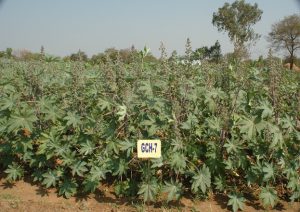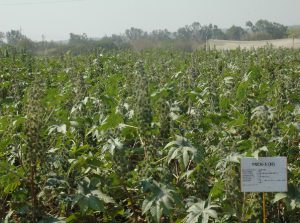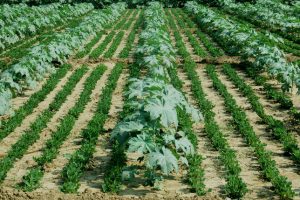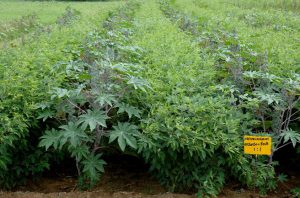Plant Breeding
Agronomy
Front line Demonstrations (FLDs)
Plant Pathology
Seed Production
Plant Breeding
- Developed world’s first castor hybrid GCH-3, an early maturing hybrid which enhanced the cropping system efficiency and encouraged Gujarat farmers to take up either wheat or summer pearl millet as a second crop wherever irrigation facilities are available.
- GCH-3 was also identified for rainfed castor growing areas due to its drought hardiness, high yield potential and high oil content.
- A total of 55 high yielding genotypes including 34 varieties and 21 hybrids were developed under the AICRP on castor and recommended for different agro-climatic regions of the country.
Promising varieties and hybrids




- Many early duration, high yielding, wilt resistant varieties and hybrids released for Southern and Central India viz., Aruna, TMV-5, TMV-6, DCS-9 (Jyothi), Kranthi, DCH-177, PCH-111, etc. increased the productivity levels in rainfed regions.
- Several medium to late maturing hybrids , GAUCH-1, GCH-2, GCH-4, GCH-7 suitable for irrigated regions of the country led to a quantum jump in productivity levels of the country.
- Around 3500 germplasm accessions were evaluated for resistance to major biotic and abiotic stresses in coordinated trials.
- Among 13 germplasm accessions registered, RG-2787 and RG-43, with multiple resistance, RG-18, an extra early maturing accession are used in the breeding programmes.
Agronomy
- Developed and recommended region specific remunerative cropping systems. Demonstrated economically viable intercropping systems of castor with pigeon pea, cluster bean, cucumber, mung bean, groundnut, maize, urd bean and sesame.
Remunerative intercrops with castor


Groundnut Pigeon pea
- Recommended optimum seed rate for both rainfed and irrigated situations, plant population, region wise fertilizer requirements and moisture conservation practices for maximizing the seed yield.
- A plant population of 18,500/ha and 14,000/ha is recommended for rainfed and irrigated areas.
- Top dressing with 20 kg N/ha each at 35-40 and 65-70 days after sowing depending upon moisture availability in the soil apart from application of a basal dose of 20 kg N fertilizer recommended for rainfed conditions, helped in realizing reasonable economic returns.
- Best management practices recommended for irrigated castor in Saurashtra and North Gujarat involved application of 30 kg N in the form of FYM, 30 kg N through castor cake, 30 kg N through green manure and 30 kg N/ha through inorganic fertilizer for reaping higher yields.
- Application of 20 kg N through castor cake, 20 kg N through FYM, 20 kg N through in situ green manuring together with 20 kg N/ha through inorganic fertilizer is recommended for integrated nutrient management under irrigated conditions in Rajasthan.
- In light soils of Gujarat, seed treatment with Azospirillum or phosphorus solubilizing bacteria (PSB) @ 50 g/kg seed, apart from application of 75-50-0 NPK/ha in conjunction with castor cake (1 t/ha) or FYM (5 t/ha) is advocated.
- In Saurashtra region of Gujarat, it has been recommended to apply 20 kg S/ha through gypsum or single super phosphate for realizing higher yields and returns.
Front line Demonstrations (FLDs)
- About 500 frontline demonstrations on full package are conducted every year. Whole package demonstrations indicated the scope for productivity enhancement from 15% to 126% in rainfed and 20% to 85% under irrigated conditions, while the overall additional net returns ranged from Rs.3126/ha to Rs. 29,598 /ha.
Plant Pathology
- Control measures for managing important diseases like Fusarium wilt and Botrytis gray mold and insect pests such as sucking pests (leafhopper, thrips), leaf eating caterpillars (semilooper, spodoptera) and capsule borer have been recommended.
- Recommended seed treatment with carbendazim (2 g/kg)/ viride (10 g/kg) for wilt endemic areas and soil application of T. viride (2.5 kg/ha) incubated in 125 kg of FYM in seed furrows.
- Demonstrated Botrytis grey management practices like spraying of propiconazole (0.1%) or hexaconazole (0.1%) two times followed by a top dressing with 20 kg N/ha after cessation of rains recorded low grey mold and highest seed yield.
Seed Production
- Based on the coordinated trials under AICRP, it is recommended to increase the isolation distance of certified hybrid seed production from 150 to 300 m and impose “refined or modified” method of seed production of pistillate line in place of conventional method of seed production.
- Concerted efforts at different AICRP (Castor) centres and IIOR, on production and supply of genetically pure breeder seed of the released varieties and parental lines of the hybrids resulted in breeder seed production in excess of the targets fixed by the Government of India. Against the total indent of 900 q, 2000 q of breeder seed was produced.

